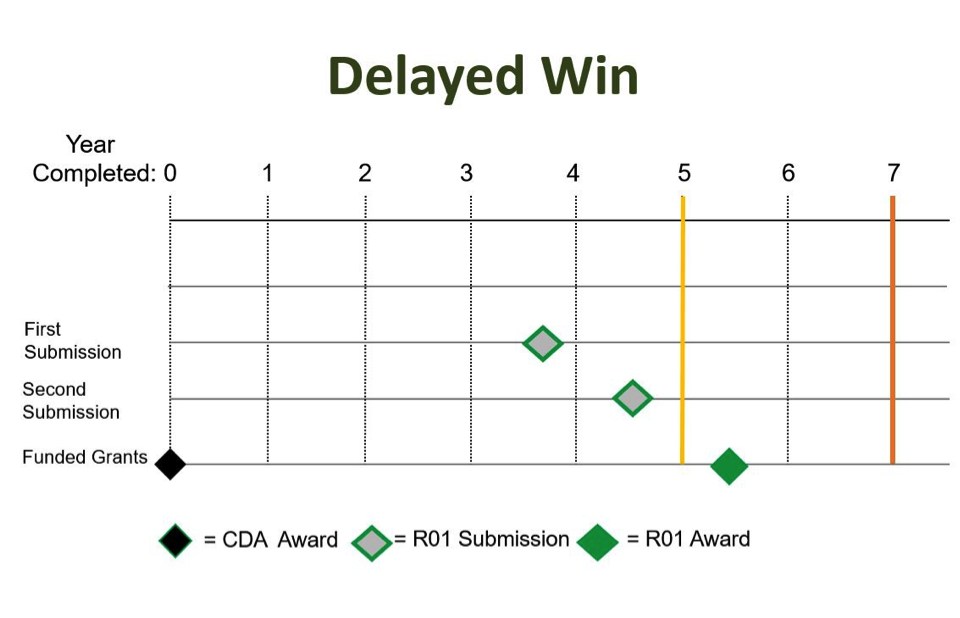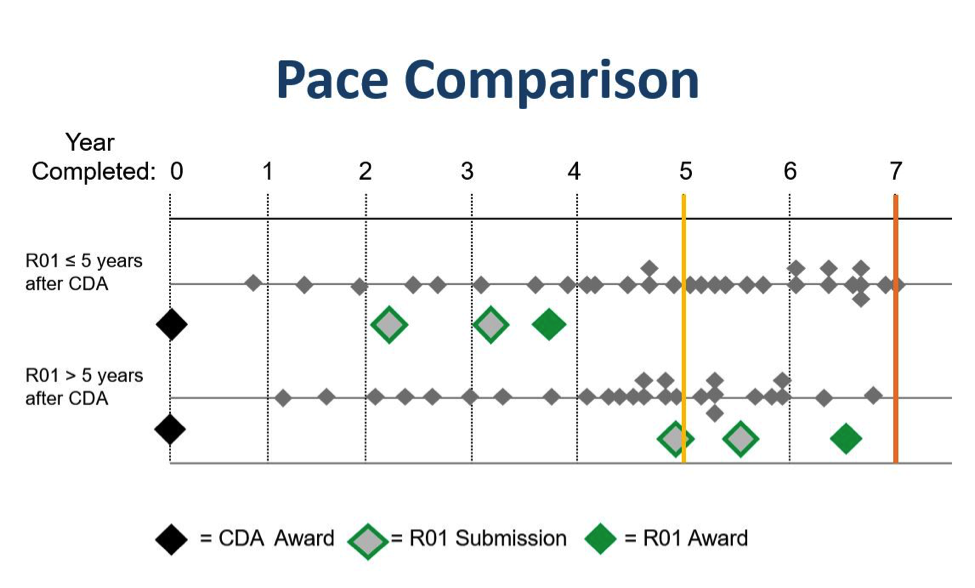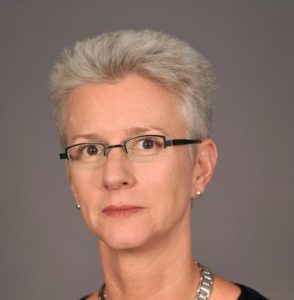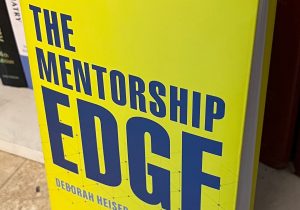Using Timelines to Diagnose Problems in Career Planning
This post builds on a presentation at the 2019 CTSA Annual Meeting of Training Program Directors.
Reviewing intended career progression is a cornerstone of mentorship. Goals for milestones such as manuscript and grant submissions typically dominate discussion. Often goals are described in documents for mentor panel meetings, individual career development plans, or alluded to in career documents like the scholar’s CV or biosketch.
In our early career faculty development programs, we’ve become convinced that looking at something is better than talking (or reading) about it. We find translating intended goals into a single simple image as a timeline is a powerful tool. Preparing the timeline requires a scholar to more deeply examine feasibility of plans by requiring they take into account timing of built in delays such as those:
- Between grant submission, review, resubmission, review, and funding.
- Typical in the review-to-publication cycle for journals to which they intend to submit.
- Allowing for submissions of manuscripts to multiple journals.
- Caused by small grants and awards pulling attention away from building their core scientific mission and research team if not perfectly aligned.
Our program’s use of timelines began with a basic retrospective examination of outcomes. We saw more timelines like the one below than we hoped. [Note R01 is an oversimplified label in our examples for all large awards including VA Merit, U01, CDC contracts, and other funding at a value of ≥$250K direct for a minimum of three years.]
The majority of our scholars are tenure track when they start their career development award. Most awards were five years long (culminating at the yellow line). At our institution, fairly firm decisions are made about remaining tenure track or changing tracks at the seven-year mark (dark orange warning line).
This is an uncomfortable, risky and potentially costly small lag in funding:
- The scholar has forfeited the benefits of being allowed up to two years of overlap of their K and first large-scale grant.
- They have fallen off the K-cliff from 75%+ protected time to PI-level effort for a single grant which creates additional funding needs.
- At the end of the K the individual does not know the score on their resubmission.
- They need bridge funding at the end of the K to continue their work.
- Delays in federal start dates, now common, can compound the pressure.
- Bridge funding at the end of a K, when work is underway and related staff may have been hired, is costlier than “pre-bridging” by allowing time for pilot work to progress further before starting a K award.
- Time to launch a new round of submissions is insufficient within the pre-tenure review window.
- The faculty member’s posture with the department can change from achiever to “needs watching.”
- If they were tenure track before receiving the K award, they are in a more profound bind.
To best advise mentees and mentors about ideal pace, we then asked what pace was implemented by K and other career development awardees who successfully transitioned from their CDA to R01 or comparable funding. We restricted to individuals who made this transition and then compared the timelines of those who made the transition within five years – the typical period of a career-development award – and those who achieved funding as an independent investigator but did so after more than five years had elapsed.
For simplicity in this aggregate analysis, we included scientific publications related to the content areas or methods of continued research and timing of submission and funding of proposals of varied types. The image below reflects the average timing of publications and R01 submissions within the two groups:
During comparison several elements of mentoring surfaced that required myth busting. Among those who took more than five years to transition many had been told:
- Earlier than the third year was too early to submit. (Not all mentors were aware of allowance for overlap of K and R.)
- Explicitly that the fourth year was fine for initial submission and some had been advised to pursue R03 or R21s first, delaying their receipt of funding sufficient to support a research team.
- They needed more or higher impact publications before submitting.
Some had attempted to submit earlier and found they:
- Received worse internal reviews than expected and needed to delay to fix flaws.
- Underestimated the overall complexity of the process.
- Did not have ideal data about feasibility and proof of concept, having focused on narrow bands of pilot data.
- Underestimated power and needed to add sites or collaborators.
- Underestimated costs, discovered this too close to intended submission and needed to re-scope their project.
Combined, these mentor and process factors were most related to delayed success. Very few faculty attributed delays to parenting or challenges outside of work. In aggregate most felt they had been naïve about the need to start earlier.
In response, we initiated grant pacing workshops to break down all the component parts of large grants and develop timelines for completion simultaneous with recommending (or requiring for some groups) that faculty scholars complete, review, and revise a timeline a minimum of twice a year for each mentor panel.
In reviewing these intended timelines (purple line marks when prepared), we have found them key for rapid diagnosis of concerns that are more difficult to detect in formal academic documents, bulleted lists of accomplishments, or text description of goals.
As an example, the faculty member below was rightly perceived by division chief and chair as highly successful, producing seven meaningful publications in solid journals, presenting at multiple national meetings including plenary sessions, and receiving a prestigious professional organization scientific award for $125K a year for two years. Everyone was happy, until they thought about the implications of this timeline submitted as part of an annual report. The individual had 18 months on tenure track prior to CDA. In this picture that means Year 5 is actually Year 7 on the tenure clock and Year 7 is Year 9, at which time they face an up-or-out promotion review without knowing until the final hour if they may qualify.
Ideally this would have been prevented by discussing the timeline in Year 1 or 2. Even as late as Year 3 of the CDA, we were able to dispel the idea that the individual could spend a year focusing predominantly on the professional association award. Mentors promoted tight integration of that award with preparation for an R that moved somewhat away from the K. This allowed earlier submission of the R, with less time elapsed before resubmission and, by very good fortune and good science, earlier receipt of funding by almost a full year.
Timelines for evaluations reveal key patterns that mentors and career development leadership can identify and disrupt to be sure timelines reflect the pace at which funding is needed and the milestones implied.
We see these as themes:
- Distracted mentors losing track of time or providing poor advice that did not emphasize necessary pace for achieving first major grant. These scholars need a real timeline!
- Over-alignment of K aims to R when some portion has not panned out or findings have proven unenticing. They need encouragement to deploy talents in related, higher value pursuits.
- Distracted scholars chasing small shiny objects. Among those who submit 7 to 11 smaller value awards during their CDA, none achieved prompt transition to independent funding. Lower numbers are also concerning. They need an ultimatum as time gets short to keep the main thing the main thing.
- Idea hamsters who submit multiple proposals with a wide range of different methods and hypotheses, and/or those who prepare publications on multiple topics that do not build to an acknowledged area of mastery. Same intervention as distracted scholars.
- Trust fund recipients who were aggressively wooed and provided robust start-up funds. They are at risk of misperceiving this as a safety net that can help support future salary needs. They often under use the funds in launching the appropriate scale of hiring and research investments. They need coaching on using their resources to accelerate the work and produce a large scale grant sooner.
- Comfort in poverty shows up as individuals who lack confidence in or do not have a personal vision for their career. They behave as if they are earlier in their careers and fail to exercise agency in decision making. They typically don’t prepare a timeline until pressed or they project too much time will elapse and ruminate on failure. They allow mentors and others to dictate what is needed rather than determining from their own goals. They need consistent encouragement to differentiate from mentors and clarify their passion for research.
- Time management fails among individuals who do life with their “hair on fire” and have multiple explanations for why key pieces of scientific endeavors or grant preparation derail without acknowledging the lack of sufficient lead time and lack of use for resources like expert review of aims and internal study section that are associated with higher levels of success. These individuals push back their timeline each time they draw it. They need accountability.
The rarest are:
- Failed scientific ideas when methods cannot be replicated or results of experiments derail intended direction.
- Mentor departures that disrupt the progress of the early career faculty member by following the mentor or needing new mentoring contacts.
The latter two are unavoidable, even with timelines, and are worthy of other forms of consideration.
The good news is the majority of scholars who start to prepare realistic timelines around the time they decide to seek a K award can march out that plan. They find it helpful and anxiety reducing. Being oriented to what one needs to do and demystifying the steps is empowering.









3 Comments
Thank you for this enlightening post. Are these data from K23 awardees primarily? What percentage of the individuals in your sample are K08 awardees conducting basic science research? Do the trends/themes differ based on whether the awardee is pursuing basic science research vs. clinical research? Has there been any research into the pace set by successful K08 awardees specifically? Thank you!
This is so enlightening – thank you so much for posting it!
Just wish I had read it sooner!
[…] years in itself, so it’s recommended that you start working on this next step in Year 3. (See here for some timeline descriptions.) So you really only have a little more than two years to put everything in place for the next […]